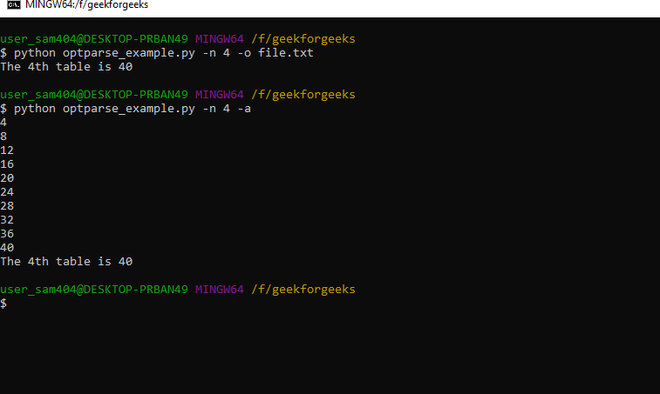Optparse module in Python
Last Updated :
30 Nov, 2022
Optparse module makes easy to write command-line tools. It allows argument parsing in the python program.
- optparse make it easy to handle the command-line argument.
- It comes default with python.
- It allows dynamic data input to change the output
Code: Creating an OptionParser object.
Python3
import optparse
parser = optparse.OptionParser()
|
Defining options:
It should be added one at a time using the add_option(). Each Option instance represents a set of synonymous command-line option string.
Way to create an Option instance are:
OptionParser.add_option(option)
OptionParser.add_option(*opt_str, attr=value, ...)
To define an option with only a short option string:
parser.add_option("-f", attr=value, ....)
And to define an option with only a long option string:
parser.add_option("--foo", attr=value, ....)
Standard Option Actions:
- “store”: store this option’s argument (default).
- “store_const”: store a constant value.
- “store_true”: store True.
- “store_false”: store False.
- “append”: append this option’s argument to a list.
- “append_const”: append a constant value to a list.
Standard Option Attributes:
- Option.action: (default: “store”)
- Option.type: (default: “string”)
- Option.dest: (default: derived from option strings)
- Option.default: The value to use for this option’s destination if the option is not seen on the command line.
Here’s an example of using optparse module in a simple script:
Python3
from optparse import OptionParser
parser = OptionParser()
parser.add_option("-f", "--file",
dest = "filename",
help = "write report to FILE",
metavar = "FILE")
parser.add_option("-q", "--quiet",
action = "store_false",
dest = "verbose", default = True,
help = "don't print status messages to stdout")
(options, args) = parser.parse_args()
|
With these few lines of code, users of your script can now do the “usual thing” on the command-line, for example:
<yourscript> --file=outfile -q
Lets, understand with an example:
Code: Writing python script for print table of n.
Python3
import optparse
def table(n, dest_cheak):
for i in range(1,11):
tab = i*n
if dest_cheak:
print(tab)
return tab
def Main():
parser = optparse.OptionParser()
parser.add_option('-n', dest = 'num',
type = 'int',
help = 'specify the n''th table number to output')
parser.add_option('-o', dest = 'out',
type = 'string',
help = 'specify an output file (Optional)')
parser.add_option("-a", "--all",
action = "store_true",
dest = "print",
default = False,
help = "print all numbers up to N")
(options, args) = parser.parse_args()
if (options.num == None):
print (parser.usage)
exit(0)
else:
number = options.num
result = table(number, options.print)
print ("The " + str(number)+ "th table is " + str(result))
if (options.out != None):
f = open(options.out,"a")
f.write(str(result) + '\n')
if __name__ == '__main__':
Main()
|
Output:
python file_name.py -n 4

python file_name.py -n 4 -o

file.txt created

python file_name.py -n 4 -a

For knowing more about this module click here.
Share your thoughts in the comments
Please Login to comment...